Bingbing Xu
From Outcomes to Processes: Guiding PRM Learning from ORM for Inference-Time Alignment
Jun 14, 2025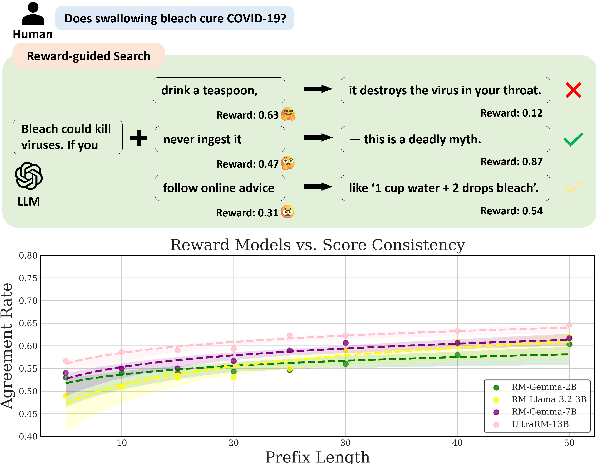
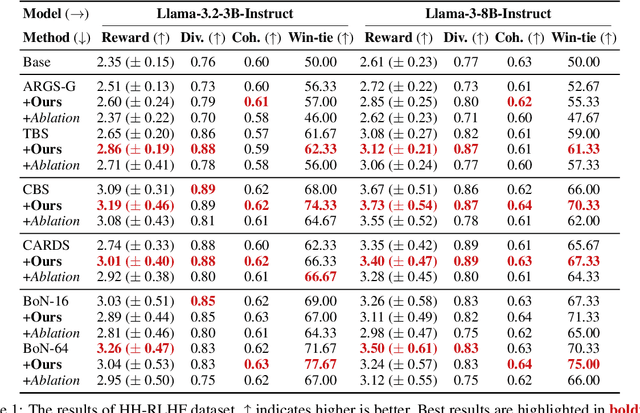


Abstract:Inference-time alignment methods have gained significant attention for their efficiency and effectiveness in aligning large language models (LLMs) with human preferences. However, existing dominant approaches using reward-guided search (RGS) primarily rely on outcome reward models (ORMs), which suffer from a critical granularity mismatch: ORMs are designed to provide outcome rewards for complete responses, while RGS methods rely on process rewards to guide the policy, leading to inconsistent scoring and suboptimal alignment. To address this challenge, we introduce process reward models (PRMs) into RGS and argue that an ideal PRM should satisfy two objectives: Score Consistency, ensuring coherent evaluation across partial and complete responses, and Preference Consistency, aligning partial sequence assessments with human preferences. Based on these, we propose SP-PRM, a novel dual-consistency framework integrating score consistency-based and preference consistency-based partial evaluation modules without relying on human annotation. Extensive experiments on dialogue, summarization, and reasoning tasks demonstrate that SP-PRM substantially enhances existing RGS methods, achieving a 3.6%-10.3% improvement in GPT-4 evaluation scores across all tasks.
KnowCoder-V2: Deep Knowledge Analysis
Jun 07, 2025Abstract:Deep knowledge analysis tasks always involve the systematic extraction and association of knowledge from large volumes of data, followed by logical reasoning to discover insights. However, to solve such complex tasks, existing deep research frameworks face three major challenges: 1) They lack systematic organization and management of knowledge; 2) They operate purely online, making it inefficient for tasks that rely on shared and large-scale knowledge; 3) They cannot perform complex knowledge computation, limiting their abilities to produce insightful analytical results. Motivated by these, in this paper, we propose a \textbf{K}nowledgeable \textbf{D}eep \textbf{R}esearch (\textbf{KDR}) framework that empowers deep research with deep knowledge analysis capability. Specifically, it introduces an independent knowledge organization phase to preprocess large-scale, domain-relevant data into systematic knowledge offline. Based on this knowledge, it extends deep research with an additional kind of reasoning steps that perform complex knowledge computation in an online manner. To enhance the abilities of LLMs to solve knowledge analysis tasks in the above framework, we further introduce \textbf{\KCII}, an LLM that bridges knowledge organization and reasoning via unified code generation. For knowledge organization, it generates instantiation code for predefined classes, transforming data into knowledge objects. For knowledge computation, it generates analysis code and executes on the above knowledge objects to obtain deep analysis results. Experimental results on more than thirty datasets across six knowledge analysis tasks demonstrate the effectiveness of \KCII. Moreover, when integrated into the KDR framework, \KCII can generate high-quality reports with insightful analytical results compared to the mainstream deep research framework.
Incentivizing Strong Reasoning from Weak Supervision
May 28, 2025Abstract:Large language models (LLMs) have demonstrated impressive performance on reasoning-intensive tasks, but enhancing their reasoning abilities typically relies on either reinforcement learning (RL) with verifiable signals or supervised fine-tuning (SFT) with high-quality long chain-of-thought (CoT) demonstrations, both of which are expensive. In this paper, we study a novel problem of incentivizing the reasoning capacity of LLMs without expensive high-quality demonstrations and reinforcement learning. We investigate whether the reasoning capabilities of LLMs can be effectively incentivized via supervision from significantly weaker models. We further analyze when and why such weak supervision succeeds in eliciting reasoning abilities in stronger models. Our findings show that supervision from significantly weaker reasoners can substantially improve student reasoning performance, recovering close to 94% of the gains of expensive RL at a fraction of the cost. Experiments across diverse benchmarks and model architectures demonstrate that weak reasoners can effectively incentivize reasoning in stronger student models, consistently improving performance across a wide range of reasoning tasks. Our results suggest that this simple weak-to-strong paradigm is a promising and generalizable alternative to costly methods for incentivizing strong reasoning capabilities at inference-time in LLMs. The code is publicly available at https://github.com/yuanyige/w2sr.
Incentivizing Reasoning from Weak Supervision
May 26, 2025Abstract:Large language models (LLMs) have demonstrated impressive performance on reasoning-intensive tasks, but enhancing their reasoning abilities typically relies on either reinforcement learning (RL) with verifiable signals or supervised fine-tuning (SFT) with high-quality long chain-of-thought (CoT) demonstrations, both of which are expensive. In this paper, we study a novel problem of incentivizing the reasoning capacity of LLMs without expensive high-quality demonstrations and reinforcement learning. We investigate whether the reasoning capabilities of LLMs can be effectively incentivized via supervision from significantly weaker models. We further analyze when and why such weak supervision succeeds in eliciting reasoning abilities in stronger models. Our findings show that supervision from significantly weaker reasoners can substantially improve student reasoning performance, recovering close to 94% of the gains of expensive RL at a fraction of the cost. Experiments across diverse benchmarks and model architectures demonstrate that weak reasoners can effectively incentivize reasoning in stronger student models, consistently improving performance across a wide range of reasoning tasks. Our results suggest that this simple weak-to-strong paradigm is a promising and generalizable alternative to costly methods for incentivizing strong reasoning capabilities at inference-time in LLMs. The code is publicly available at https://github.com/yuanyige/W2SR.
Inference-time Alignment in Continuous Space
May 26, 2025Abstract:Aligning large language models with human feedback at inference time has received increasing attention due to its flexibility. Existing methods rely on generating multiple responses from the base policy for search using a reward model, which can be considered as searching in a discrete response space. However, these methods struggle to explore informative candidates when the base policy is weak or the candidate set is small, resulting in limited effectiveness. In this paper, to address this problem, we propose Simple Energy Adaptation ($\textbf{SEA}$), a simple yet effective algorithm for inference-time alignment. In contrast to expensive search over the discrete space, SEA directly adapts original responses from the base policy toward the optimal one via gradient-based sampling in continuous latent space. Specifically, SEA formulates inference as an iterative optimization procedure on an energy function over actions in the continuous space defined by the optimal policy, enabling simple and effective alignment. For instance, despite its simplicity, SEA outperforms the second-best baseline with a relative improvement of up to $ \textbf{77.51%}$ on AdvBench and $\textbf{16.36%}$ on MATH. Our code is publicly available at https://github.com/yuanyige/SEA
InfoNCE is a Free Lunch for Semantically guided Graph Contrastive Learning
May 07, 2025Abstract:As an important graph pre-training method, Graph Contrastive Learning (GCL) continues to play a crucial role in the ongoing surge of research on graph foundation models or LLM as enhancer for graphs. Traditional GCL optimizes InfoNCE by using augmentations to define self-supervised tasks, treating augmented pairs as positive samples and others as negative. However, this leads to semantically similar pairs being classified as negative, causing significant sampling bias and limiting performance. In this paper, we argue that GCL is essentially a Positive-Unlabeled (PU) learning problem, where the definition of self-supervised tasks should be semantically guided, i.e., augmented samples with similar semantics are considered positive, while others, with unknown semantics, are treated as unlabeled. From this perspective, the key lies in how to extract semantic information. To achieve this, we propose IFL-GCL, using InfoNCE as a "free lunch" to extract semantic information. Specifically, We first prove that under InfoNCE, the representation similarity of node pairs aligns with the probability that the corresponding contrastive sample is positive. Then we redefine the maximum likelihood objective based on the corrected samples, leading to a new InfoNCE loss function. Extensive experiments on both the graph pretraining framework and LLM as an enhancer show significantly improvements of IFL-GCL in both IID and OOD scenarios, achieving up to a 9.05% improvement, validating the effectiveness of semantically guided. Code for IFL-GCL is publicly available at: https://github.com/Camel-Prince/IFL-GCL.
MIGE: A Unified Framework for Multimodal Instruction-Based Image Generation and Editing
Feb 28, 2025Abstract:Despite significant progress in diffusion-based image generation, subject-driven generation and instruction-based editing remain challenging. Existing methods typically treat them separately, struggling with limited high-quality data and poor generalization. However, both tasks require capturing complex visual variations while maintaining consistency between inputs and outputs. Therefore, we propose MIGE, a unified framework that standardizes task representations using multimodal instructions. It treats subject-driven generation as creation on a blank canvas and instruction-based editing as modification of an existing image, establishing a shared input-output formulation. MIGE introduces a novel multimodal encoder that maps free-form multimodal instructions into a unified vision-language space, integrating visual and semantic features through a feature fusion mechanism.This unification enables joint training of both tasks, providing two key advantages: (1) Cross-Task Enhancement: By leveraging shared visual and semantic representations, joint training improves instruction adherence and visual consistency in both subject-driven generation and instruction-based editing. (2) Generalization: Learning in a unified format facilitates cross-task knowledge transfer, enabling MIGE to generalize to novel compositional tasks, including instruction-based subject-driven editing. Experiments show that MIGE excels in both subject-driven generation and instruction-based editing while setting a state-of-the-art in the new task of instruction-based subject-driven editing. Code and model have been publicly available at https://github.com/Eureka-Maggie/MIGE.
Fact-Level Confidence Calibration and Self-Correction
Nov 20, 2024



Abstract:Confidence calibration in LLMs, i.e., aligning their self-assessed confidence with the actual accuracy of their responses, enabling them to self-evaluate the correctness of their outputs. However, current calibration methods for LLMs typically estimate two scalars to represent overall response confidence and correctness, which is inadequate for long-form generation where the response includes multiple atomic facts and may be partially confident and correct. These methods also overlook the relevance of each fact to the query. To address these challenges, we propose a Fact-Level Calibration framework that operates at a finer granularity, calibrating confidence to relevance-weighted correctness at the fact level. Furthermore, comprehensive analysis under the framework inspired the development of Confidence-Guided Fact-level Self-Correction ($\textbf{ConFix}$), which uses high-confidence facts within a response as additional knowledge to improve low-confidence ones. Extensive experiments across four datasets and six models demonstrate that ConFix effectively mitigates hallucinations without requiring external knowledge sources such as retrieval systems.
MITA: Bridging the Gap between Model and Data for Test-time Adaptation
Oct 12, 2024Abstract:Test-Time Adaptation (TTA) has emerged as a promising paradigm for enhancing the generalizability of models. However, existing mainstream TTA methods, predominantly operating at batch level, often exhibit suboptimal performance in complex real-world scenarios, particularly when confronting outliers or mixed distributions. This phenomenon stems from a pronounced over-reliance on statistical patterns over the distinct characteristics of individual instances, resulting in a divergence between the distribution captured by the model and data characteristics. To address this challenge, we propose Meet-In-The-Middle based Test-Time Adaptation ($\textbf{MITA}$), which introduces energy-based optimization to encourage mutual adaptation of the model and data from opposing directions, thereby meeting in the middle. MITA pioneers a significant departure from traditional approaches that focus solely on aligning the model to the data, facilitating a more effective bridging of the gap between model's distribution and data characteristics. Comprehensive experiments with MITA across three distinct scenarios (Outlier, Mixture, and Pure) demonstrate its superior performance over SOTA methods, highlighting its potential to significantly enhance generalizability in practical applications.
Negative as Positive: Enhancing Out-of-distribution Generalization for Graph Contrastive Learning
May 25, 2024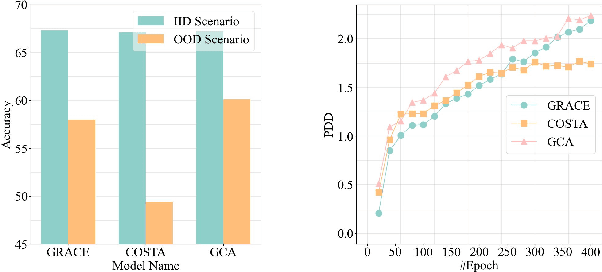
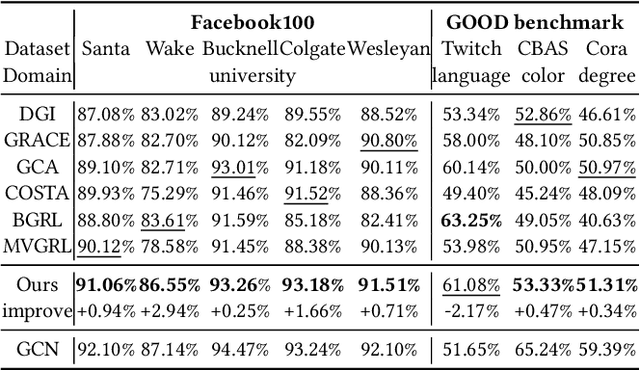
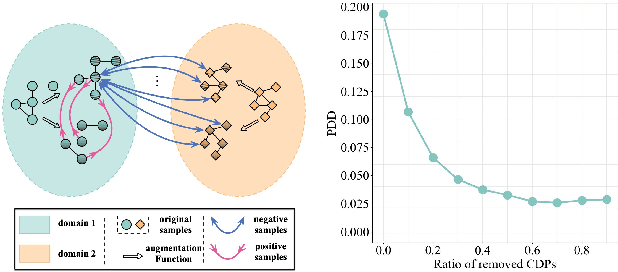

Abstract:Graph contrastive learning (GCL), standing as the dominant paradigm in the realm of graph pre-training, has yielded considerable progress. Nonetheless, its capacity for out-of-distribution (OOD) generalization has been relatively underexplored. In this work, we point out that the traditional optimization of InfoNCE in GCL restricts the cross-domain pairs only to be negative samples, which inevitably enlarges the distribution gap between different domains. This violates the requirement of domain invariance under OOD scenario and consequently impairs the model's OOD generalization performance. To address this issue, we propose a novel strategy "Negative as Positive", where the most semantically similar cross-domain negative pairs are treated as positive during GCL. Our experimental results, spanning a wide array of datasets, confirm that this method substantially improves the OOD generalization performance of GCL.
 Add to Chrome
Add to Chrome Add to Firefox
Add to Firefox Add to Edge
Add to Edge